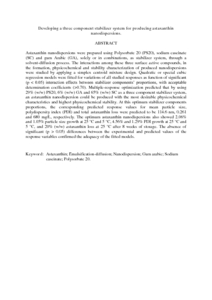Citation
Anarjan, Navideh and Tan, Chin Ping
(2013)
Developing a three component stabilizer system for producing astaxanthin nanodispersions.
Food Hydrocolloids, 30 (1).
pp. 437-447.
ISSN 0268-005X; ESSN: 1873-7137
Abstract
Astaxanthin nanodispersions were prepared using Polysorbate 20 (PS20), sodium caseinate (SC) and gum Arabic (GA), solely or in combinations, as stabilizer system, through a solvent-diffusion process. The interactions among these three surface active compounds, in the formation, physicochemical and stability characterization of produced nanodispersions were studied by applying a simplex centroid mixture design. Quadratic or special cubic regression models were fitted for variations of all studied responses as function of significant (p < 0.05) interaction effects between stabilizer components’ proportions, with acceptable determination coefficients (>0.70). Multiple-response optimization predicted that by using 29% (w/w) PS20, 6% (w/w) GA and 65% (w/w) SC as a three component stabilizer system, an astaxanthin nanodispersion could be produced with the most desirable physicochemical characteristics and highest physicochemical stability. At this optimum stabilizer components proportions, the corresponding predicted response values for mean particle size, polydispersity index (PDI) and total astaxanthin loss were predicted to be 114.6 nm, 0.261 and 680 mg/L, respectively. The optimum astaxanthin nanodispersions also showed 2.06% and 1.05% particle size growth at 25 °C and 5 °C, 4.56% and 1.29% PDI growth at 25 °C and 5 °C, and 20% (w/w) astaxanthin loss at 25 °C after 8 weeks of storage. The absence of significant (p > 0.05) differences between the experimental and predicted values of the response variables confirmed the adequacy of the fitted models.
Download File
![[img]](http://psasir.upm.edu.my/30438/1.hassmallThumbnailVersion/Developing%20a%20three%20component%20stabilizer%20system%20for%20producing%20astaxanthin%20nanodispersions.pdf)  Preview |
|
PDF (Abstract)
Developing a three component stabilizer system for producing astaxanthin nanodispersions.pdf
Download (187kB)
| Preview
|
|
Additional Metadata
Actions (login required)
 |
View Item |

